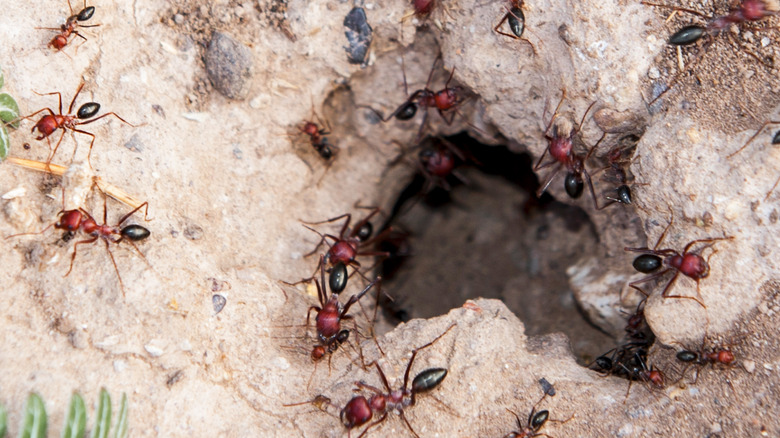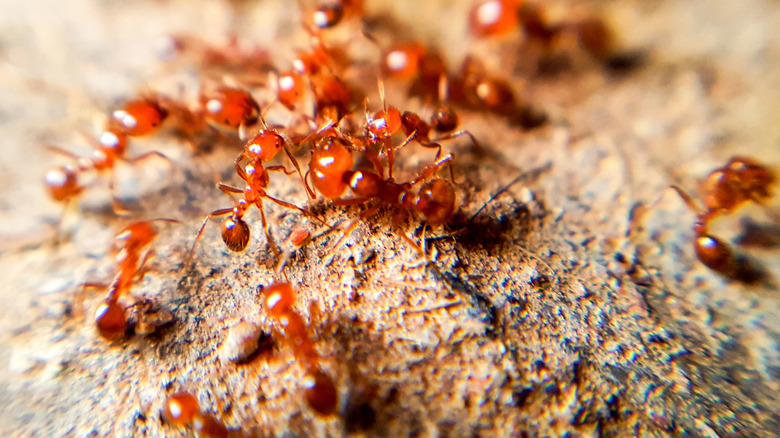How To Tell If The Ant Mound In Your Yard Is Full Of Fire Or Regular Ants
Ants are one of the most prolific animals on earth. In fact, there are about 20 quadrillion of them in the world — that's about 2.5 million of these insects for every human being alive. These tiny critters can crawl their way into any space that isn't absolutely airtight, and they will if they smell a suitable food source. Ants will make their way through thick and thin to get the supplies they need, but once they've got them, they'll typically head right back to their mound.
Their mounds are prevalent in our yards and can be a point of anxiety, especially if you have young children or pets. While some ants are generally harmless to us in terms of stinging, others like the infamous fire ants should be looked out for. If you discover a mound in your backyard and you're not sure what type of ant it belongs to, pay attention to things like location, color, size, and holes in the mound, as well as the appearance and actions of the insects themselves.
Fire ants are notoriously unpleasant, and rightfully so. Not only are their stings very painful, but they are also very aggressive, more so than most other types. Their stings are quite dangerous, especially if you have the tendency to be hypersensitive. It's crucial that you be able to identify a fire ant mound right away so that you can take the necessary steps to get rid of the ants.
Differentiate between regular and fire ant mounds
Having ant mounds in your yard isn't a good thing period, but you'd much rather have a regular ant infestation than a fire one. If you're struggling to tell which species the mound near you belongs to, these tricks are bound to lend you a hand. Regular ant mounds have clear openings where the insects can come and go as they please. On the other hand, fire mounds don't have this feature. Also, fire mounds are usually reddish-brown because of the type of soil used to make them. However, they may just be brown like a regular ant mound, so the color isn't always a surefire way to tell.
Fire ants also like to make their mounds directly under the sun in wide, open spaces. This is different than regular types, which can erect their mounds anywhere. When it comes to the sizes, fire ants build their mounds quite high compared to regular ants. Their mounds can grow up to 18 inches high and 30 inches wide, so they'd stand out pretty easily. Fire types also rebuild their nest very quickly if disturbed, unlike regular ones which tend to take a varied amount of time depending on which species they belong to.
Check the ants' characteristics and behavior
Because fire ants are known for their aggression, you can use the stick method to determine if the mound in your yard is full of them or not. Using a suitably-long stick, stab the mound and watch what happens. Regular ants aren't likely to react quickly. If they do come out, it probably won't be a malicious attack. In comparison, fire types will heap out in droves, seeking for anything to sting and attack. Once they're identified, there are ways to get rid of fire ants and regular ants without getting stung. You can feed them borax or baking soda to poison them. Once the queen dies, the colony won't have a way of creating new ants and will eventually disintegrate.
One thing you have to keep in mind is that, while fire ants are usually red, not all red ants are fire ants. It's imperative not to confuse them. Fire types possess two little bumps wedged between their thorax and their abdomen. To get a close-enough look, you can capture some of the insects and use a magnifying glass to inspect them. Throw on some latex gloves that are coated in baby powder so the critters can't climb them. Then, place a tube or small container of isopropyl alcohol onto the mound and quickly move away. Curious ants will peep out, climb into the container, and die. You can then remove the container and check the anatomy of your samples.


